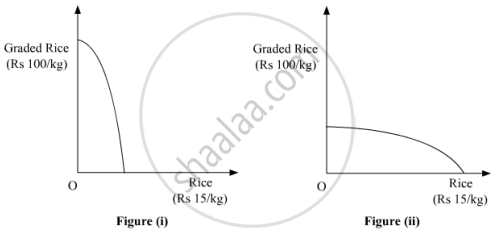Advertisements
Advertisements
प्रश्न
Answer the following question.
Explain the central problem for whom to produce.
Explain the problem of for whom to produce.
With the help of suitable example explain the problem of ‘for whom to produce’.
उत्तर १
Central problem - ‘For whom to produce’:-
For whom to produce’ refers to the problem of distribution of final goods and services or the problem of distribution of income. It has two aspects. The first aspect relates to personal distribution and the second aspect relates to functional distribution. Personal distribution refers to output/income share of individuals or households in society. Functional distribution refers to income share of different factors of production. Here, the problem is whether allocation of resources is promoting equality or not. Equality is a social virtue, and inequality may induce high saving, investment and hence high rate of growth.
उत्तर २
The central problem for whom to produce is the problem of allocation of resources. This relates to the distribution of national products among the various individuals. It is true that sharing of national product is directly influenced by the income of an individual. People having higher income will definitely possess higher purchasing capacities. Therefore, for proper and equal distribution of goods and services, there should be equality of income among all the people of the society. Thus, we can observe that every economy faces the problem of allocating its national resources to the production of different goods and services and of distributing the produced goods and services among the individuals within the economy.
उत्तर ३
This economic problem basically focuses on the distribution mix of the final goods and services produced. The distribution of the final goods and services is equivalent to the distribution of National Income (or National Product) among the factors of production such as land, labour, capital and entrepreneur.
For instance, imagine an economy producing two goods- normal rice (priced at Rs 15/kg) and graded rice (priced at Rs 100/kg). If the economy decided to cater to the needs of the lower section of the society, then it would produce more of normal rice and less of the graded rice. In such a case, the PPC curve will be as depicted in figure (ii).
On the other hand, if the economy decided to cater to the needs of the higher section of the society, then it would produce more of the graded rice and less of the normal rice. In such a case, the PPC curve will be as depicted in figure (i).

उत्तर ४
The economic problem for whom to produce basically focuses on the distribution mix of the final goods and services produced. The distribution of the final goods and services is equivalent to the distribution of National Income (or National Product) among the factors of production such as land, labour, capital, and entrepreneur.
The economy needs to decide a mechanism of distributing the final goods and services among the different segments of the population, so as to reduce the inequality of income. This problem is concerned about who gets more or who gets less? Which goods should be made available free or at a low (nominal) price and to which segment?
The problem for whom to produce can be divided into two main aspects:
- Personal Distribution - It implies the distribution of the national income of a country among the different groups of people in a society.
- Functional Distribution - It implies how the total national product of a country is shared among the different factors of production.
APPEARS IN
संबंधित प्रश्न
Why do central problems of an economy arise?
Define Consumption Goods.
Find Net Value added at Market Price:
|
S.No |
Items |
Amount |
|
(i) |
Depreciation (Rs) |
700 |
|
(ii) |
Output sold (units) |
900 |
|
(iii) |
Price per unit of output (Rs) |
40 |
|
(iv) |
Closing stock (Rs) |
1,000 |
|
(v) |
Opening stocks (Rs) |
800 |
|
(vi) |
Sales tax (Rs) |
3,000 |
|
(vii) |
Intermediate cost (Rs) |
20,000 |
Discuss the central problems of an economy.
Answer the following question.
Why does an economic problem arise? Explain.
Assertion (A): Car purchased by the hotel for the purpose of tourism facilitation is a Capital Good.
Reason (R): The car is purchased by the hotel to provide long term service to the consumers.
What is the root cause of all economic problems?
Choose the correct statement.
Which of the following is not a central problem of an economy?
Refer to the passage below and answer the following question.
| The economic problem is the problem of choice. The problem of choice has to be faced by every economy of the world, whether developed or developing. Human beings have wants that are unlimited. Economic problems are reflected in the form of Central or Basic Problems of an economy. Any economy whether market, centrally planned or mixed has to face these problems. In economic analysis, the concept of opportunity cost is widely used. Opportunity cost is defined as the cost of an alternative opportunity given up or surrendered. |
The problem of choice is faced by ______
What all is covered under the allocation of resources?
Goods purchased for the following purpose are final goods:
Assertion (A): The flour purchased by a baker is considered an intermediate good.
Reason (R): The flour is used for the production of bread, cakes, and biscuits to be sold to the consumer.
Identify the correctly matched item from Column A to that of Column B:
| Column A | Column B | ||
| (1) | Tea Industry | (a) | Monopoly |
| (2) | Ship Building industry | (b) | Perfect Competition |
| (3) | Oil Producing Countries | (c) | Oligopoly |
| (4) | Food Market | (d) | Monopoly |
